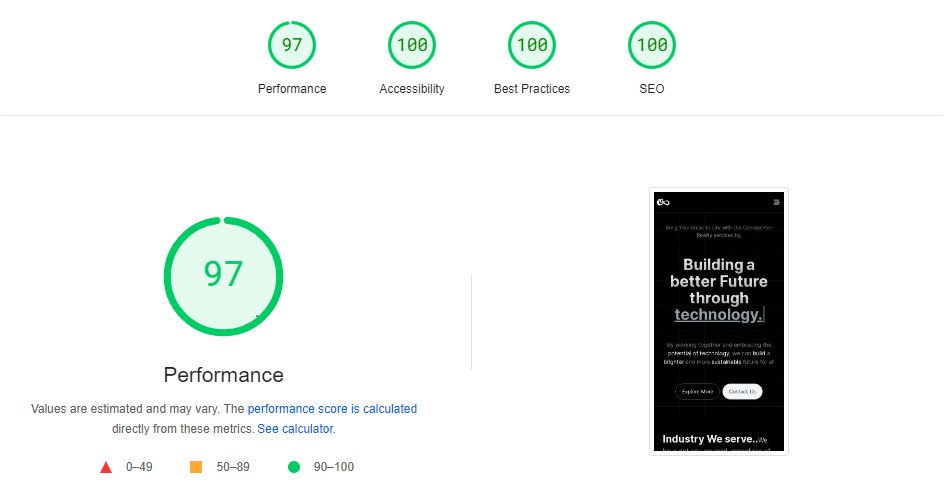Next.js, the React framework powering sleek, server-rendered wonders. But even supersonic spaceships need a tune-up, right? In this blog, we’ll blast off into the world of Next.js optimization, equipping you with tips and tricks to make your app a speedy comet zooming past competitors.
Why Optimize?
Think of your app as a sleek sports car. It purrs with potential, but a bogged-down engine leaves you stuck at the starting line. Optimizing is like revving that engine, turning your app into a lightning bolt that leaves users awestruck. Faster loading times mean happier visitors, better SEO, and ultimately, success.
Pre-launch Prep: Building with Speed in Mind
Code Splitting: Imagine shoving your entire wardrobe into a single suitcase. Not efficient, right? Code splitting breaks your app into smaller chunks, loading only what’s needed on each page. Think of it as packing light for a smooth journey.
Image Optimization: Images, those beautiful storytellers, can be hefty beasts. Use
next/imagefor automatic resizing and compression, lazy loading, keeping visuals stunning without weighing down your app. We also recommend you to use CDN such as https://imagekit.io/Font Facelift: Fancy fonts add personality, but loading tons of them can be a drag. Use
next/fontto optimize font loading, keeping your app sleek and stylish without the performance penalty.Third-Party Scrutiny: Those cool widgets and analytics tools are awesome, but they can be performance vampires. Minimize external scripts and optimize their loading for a smoother ride.
Post-Launch Polish: Fine-tuning for Peak Performance
Bundle Analysis: Ever wondered what’s lurking in your code bundles? Tools like
@next/bundle-analyzerX-ray your app, revealing heavy components and unused code. Trim the fat for a leaner, meaner app.Caching: Remember that Delicious Cookie? Caching stores frequently accessed data, like static assets, so your app doesn’t have to bake it fresh every time. Less baking, more blazing speed!
Data Fetching Dexterity: Fetching data is essential, but inefficient methods can slow things down. Choose the right tool for the job:
getStaticPropsfor static pages,getServerSidePropsfor dynamic updates, anduseSWRfor reactive data.Performance Monitoring: Keeping an eye on your app’s performance is crucial. Use tools like Lighthouse and Next.js Speed Insights to identify bottlenecks and track progress. Think of it as having a pit crew constantly checking your app’s vitals.
Bonus Tips: Tools of the Trade
- Production Build Magic: Minify and gzip your code for maximum compression. Think of it as squeezing every ounce of performance out of your app.
- Preconnect for the Future: Tell the browser which external resources your app needs, like fonts or analytics trackers, even before a user clicks. It’s like pre-packing your bags for that next page visit.
- Lazy Loading: Patience is a Virtue: Don’t force users to wait for everything to load at once. Lazy load components and content as they scroll down, keeping them engaged and the experience smooth.
Remember: Optimizing is an ongoing journey, not a one-time fix. Experiment, monitor, and refine your approach to keep your Next.js app zipping towards the finish line. With these tips, you’ll transform your app from a sluggish sedan into a sleek, high-performance rocket, leaving users starry-eyed and your competitors in the dust.
Global Reach with CDNs: Serving Speed Worldwide
- Content Delivery Networks (CDNs): Imagine having your app’s assets stored in multiple locations around the globe. CDNs do just that, dramatically reducing loading times for users worldwide. It’s like having a global network of warehouses delivering your app’s content at lightning speed.
CloudFronting for Edge Caching:
- Amazon CloudFront: This powerful CDN, combined with Next.js’s built-in edge caching, caches your content at edge locations closer to users. It’s like having a super-fast delivery service with mini-warehouses right in your neighborhood.
Hosting Haven: Finding Your App’s Perfect Home
- Firebase: Serverless hosting with a global CDN and generous free tier, making it a great choice for smaller Next.js apps. It’s like having a friendly landlord who also happens to be a tech wizard.
- Vercel: Created by the makers of Next.js, providing seamless integration, automatic optimization, and features like serverless functions. It’s like living in a smart home designed specifically for Next.js apps.
- Netlify: Another popular option with a global CDN, custom domain support, and easy deployment from Git repositories. It’s like moving into a cozy community of fellow Next.js enthusiasts.
Every Byte Counts: Image and Component Optimization
- Compressed Images: Use tools like TinyPNG or Squoosh to reduce image sizes without sacrificing quality. It’s like shrinking your luggage without leaving any essentials behind.
- Lazy Loading Components: Load components only when needed, especially for those below the fold. It’s like inviting guests to your party in waves, ensuring a smooth and comfortable experience for everyone.
Keywords: Next.js, performance optimization, code splitting, image optimization, font optimization, third-party scripts, bundle analysis, caching, data fetching, Lighthouse, Next.js Speed Insights, minification, gzipping, preconnect, lazy loading.


